| New York
Architecture Images-Chelsea The Nomadic Museum |
|
|
architect |
Shigeru Ban, artist Gregory Colbert |
|
location |
Pier 54, Chelsea, West Side. |
|
date |
March 5 through June 6, 2005 |
|
style |
Late Modern (International Style III) |
|
construction |
shipping container walls, steel roof supported by cardboard trusses |
|
type |
Gallery |
| This is really quite good. It's almost churchlike within. Very peaceful, and a perfect setting for the artwork. | |
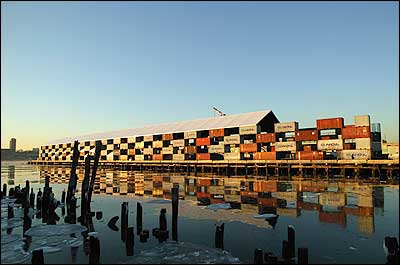 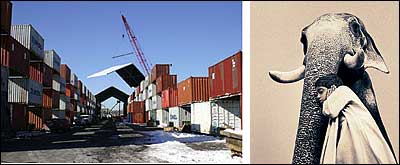
Photographs by Gregory Colbert |
|
 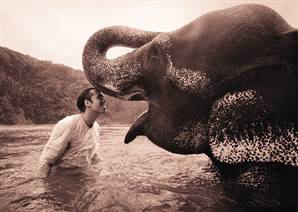
|
|
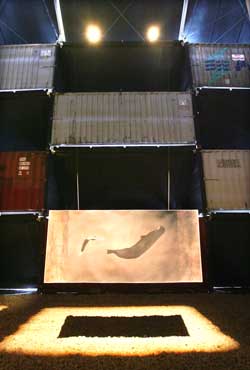 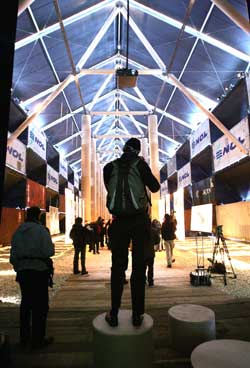 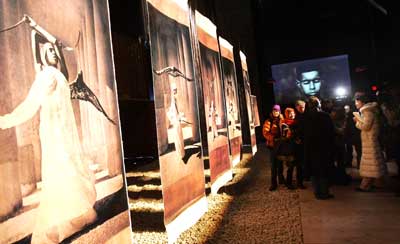
|
|
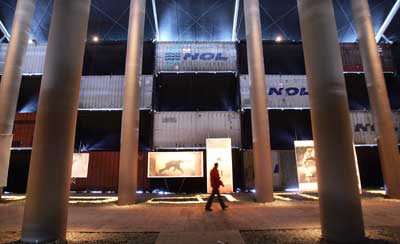 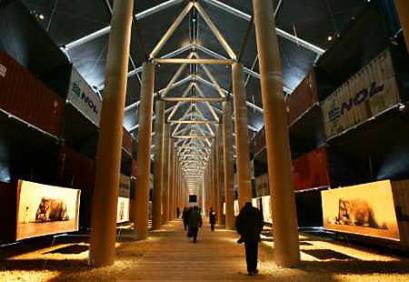 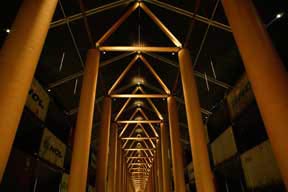
|
|
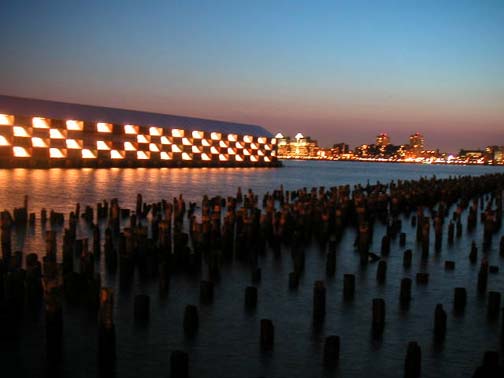 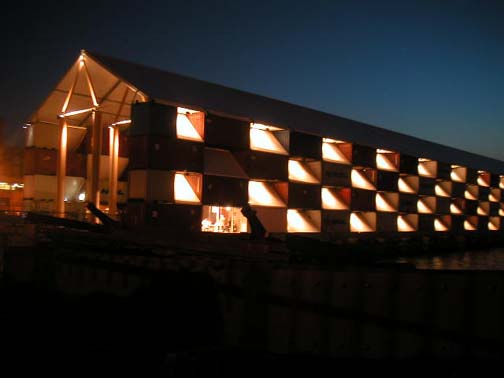
|
|
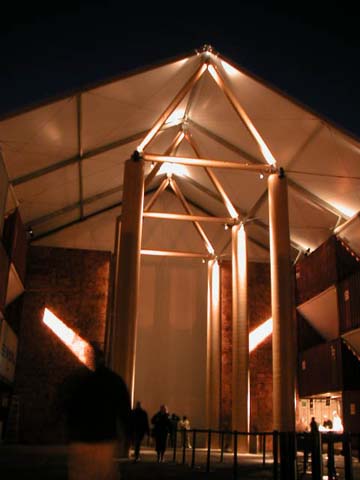 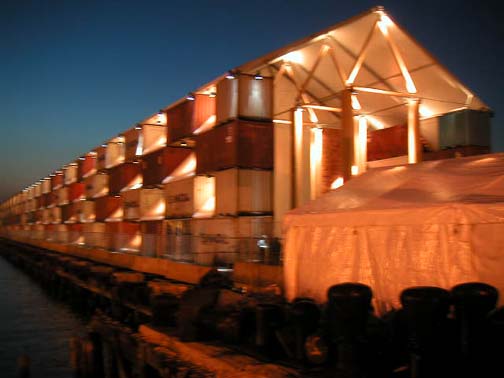
|
|
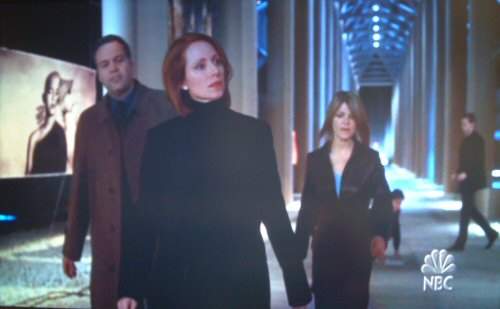
|
|
| A scene from the NBC show "Law and Order" | |
|
|
|
|
|
|
|
|
|
|
February 24, 2005
A Dockworkers' Strike? No, It's Art By ROBIN POGREBIN 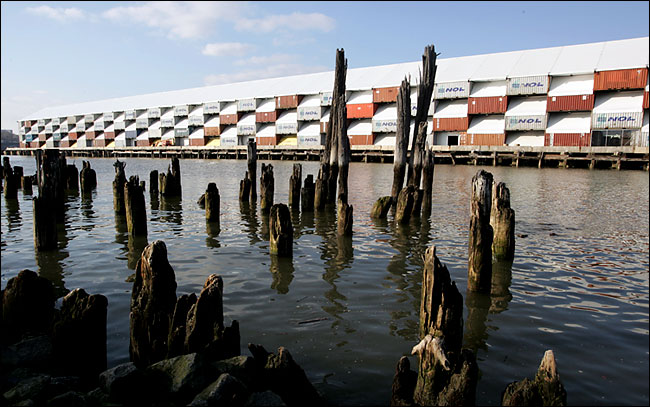 The 45,000-square-foot mobile museum on Pier 54. 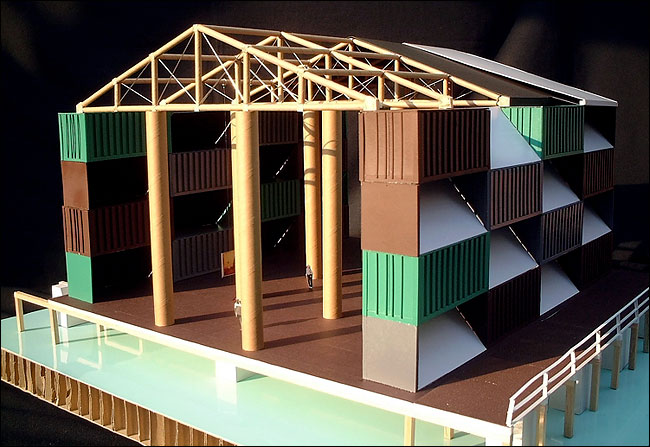 A model of the museum. But in fact, they are passing not just the historic pier on the Hudson River at 13th Street where the Titanic's survivors were discharged, but also a new museum designed by the Tokyo architect Shigeru Ban. The 45,000-square-foot structure was expressly built to display "Ashes and Snow," a show of 200 large-scale photographic works by the artist Gregory Colbert that opens March 5 and runs through June 6 before traveling to California and the Vatican. It's not just the show that's going out on the road. The entire museum is to be packed in 37 of the 148 cargo containers that form its checkerboard walls. The temporary structure is composed largely of recyclable materials: the roof and columns are made of paper tubes, the steel containers stacked 34 feet high are used, and a handmade curtain to be suspended from the ceiling is made of one million pressed paper tea bags (used, with the tea leaves removed). "Shigeru is the Mozart of sustainable architecture," Mr. Colbert said. "Also, from a philosophical point of view, he's done some great public buildings; he says that art shouldn't be for the privileged." Mr. Colbert, whose work seeks to capture the mystical relationship between humans and animals, said he approached Mr. Ban because he admired his use of unorthodox materials. The architect's previous designs include the paper tube arch constructed in the sculpture garden of the Museum of Modern Art, the Paper Museum and Paper Church in Japan, and the Paper Refugee Shelter, made of plastic sheets and paper tubes for the United Nations high commissioner for refugees. Mr. Colbert said he wanted the Nomadic Museum, like those other Ban projects, to seem accessible to a wide audience. "The structure shouldn't be intimidating," he said. "It should feel really inviting. It's a bridge between the arts and the natural sciences. It's not art with a capital A." Dean Maltz of Manhattan is the associate architect on the project. The host of the show is the Hudson River Park Trust, which runs the pier and is being paid a fee. Constructing the museum hasn't been easy. "You're building on a pier which is a relic, you're over water, and you're trying to build in New York," William Goins, the museum's project manager and producer of an "Ashes and Snow" documentary film, said on a recent bitter cold day. As construction continued inside the museum, the shipping containers offered little protection from the wind, though fabric will be stretched across the spaces between them. "People should come with a coat," Mr. Ban said. He said he was attracted to the project by Mr. Colbert's photographs of elephants and whales - "quite ancient animals," he said - and the ephemeral quality of the building itself. "His incredible idea of moving a huge museum was an interesting challenge," he said. Mr. Ban chose shipping containers because they had age. "Traveling all over the world," he added, "each container has its own history." Other than those used to transport the museum, the containers will change with each location. The gallery's main artery is a wooden walkway bordered by stone-filled bays over which Mr. Colbert's unframed artworks will hang from thin cables and suspension rods installed between the 64 columns. The peaked roof trusses are partly made of one-foot-diameter paper tubes that rest on the containers and on columns. The center of the museum will feature a floating library where turned pages of the artist's books will project images on the walls. A one-hour film by Mr. Colbert, narrated by Laurence Fishburne, will be continuously projected on a wall in a theater at the museum's far end. Mr. Colbert, a Canadian-born artist, began his career in Paris making documentary films about social issues, which led to his work as a fine arts photographer. His first show, "Timewaves," was in 1991 at the Museé de l'Élysée in Lausanne, Switzerland. "Ashes and Snow" is organized by Mr. Colbert's Bianimale Foundation, a nonprofit arts and nature conservation group he conceived in 2000 with Giuli Cordara, an environmentalist, the foundation's president. The exhibition is underwritten by Rolex, which helped support the first show of "Ashes and Snow" in 2002 at the Venice Arsenale. The museum and exhibition will be at the Santa Monica Pier in California from Dec. 4 through Feb. 28, 2006, and at the Vatican in summer 2006. Mr. Ban said that he would redesign the museum slightly each time it moves "depending on different site conditions" but that neither this nor the building's impermanence presented a problem. "Three months or three years is not important for me, because the idea lasts," he said. "It can be seen by more people all over the world if it moves," he added. "Maybe it remains in your memory if it's gone." 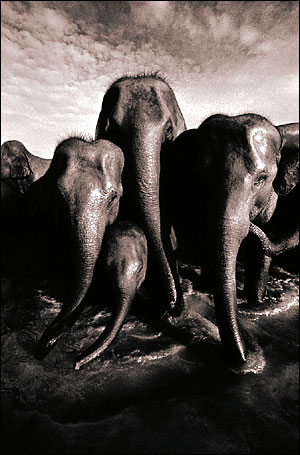 The mobile museum will house photographs by Gregory Colbert. Copyright 2005 The New York Times Company |
|
|
February 27, 2005
MEATPACKING DISTRICT Wrenches in Hand, Critics in Hard Hats Take the Measure of Their Creation By JOHN FREEMAN GILL 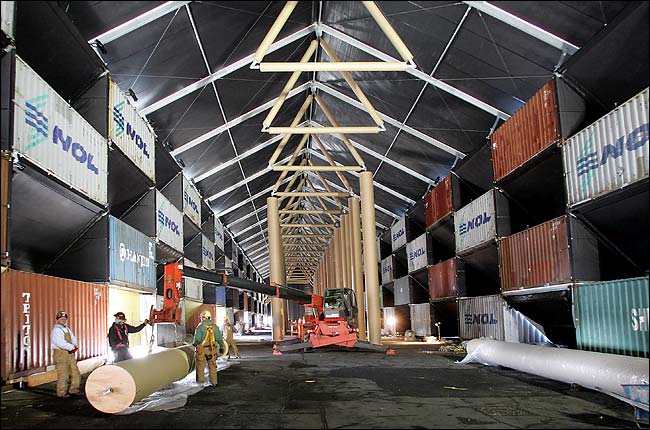 Putting final touches on the Nomadic Museum. "I guess it's some sort of minimalism," a dock builder said. When the show opens on Saturday, critics will have their say. But in recent months Pier 54 has been nothing more than a vast and bizarre construction site, and the only museumgoers have been workers in canvas overalls who have been taking delivery of outsize recycled materials from river barges and assembling them in an odd and painstaking fashion. Which invites the question: What do these workers make of what is probably the most peculiar structure most of them have ever worked on? "From what I'm told, it's art," said a cherry-picker operator named Mike Ferry, an expressive smirk spreading across his face as he sat in the cab of his big machine on a recent afternoon. William Dandorf, a dock builder, added with a shrug: "It's all for art. Somebody wants to look at art." As a groaning red crane hoisted ashore a 34-foot column resembling a gargantuan toilet-paper tube, a dock builder named Erik Romero squinted in thought. "I guess it's some sort of minimalism," he said finally. "It didn't take much to build a huge structure. I mean, it took a lot, but. ..." Like many of the laborers who had been working seven-day weeks since construction of the museum began in December, Jeff Blake was finally starting to take pleasure in looking at the strange building, whose difficult construction had made the workers virtual strangers to their families. "The more and more you bring it together," he said, "it looks nice." Perhaps because the project has been all-consuming for so long, some workers are looking forward to showing their families what has been occupying them. Among them was Mr. Ferry, the cherry-picker operator. "When it opens up," he said as he delicately maneuvered three co-workers toward the pinnacle of a column, "I will bring my wife, because it's part of her life, too, because of me not being home. I'd like her to see it." Copyright 2005 The New York Times Company |
|
|
Nomadic Museum to camp on pier for three months By Hemmy So Work is finishing on a colossal temporary museum, made from 148 shipping containers, on Pier 54 at W. 13th St. Recently relocated from Venice, the Nomadic Museum, designed by Japanese architect Shigeru Ban, creates a 45,000-sq.-ft. space from the multi-colored steel shipping containers and recycled paper tubes — used to make the roof. “Ashes and Snow,” a multi-media exhibit by artist Gregory Colbert, opens on March 5 in the Nomadic Museum and runs through June 6. The exhibit includes 199 large-scale photographs and a one-hour 35-mm film edited by Oscar winner Pietro Scalia and narrated by actor Lawrence Fishburne. “I hope the Nomadic Museum will create an unforgettable experience, demonstrating unique architectural concepts and sustainable practices with a post-industrial feel,” Ban said. Ban is known for his structures made from unexpected materials, including the Paper Tube Arch in the Museum of Modern Art sculpture garden. But most here know Ban as the leader of
THINK, one of the architectural teams that proposed a design for the new
World Trade Center site plan. His team’s plan, which imagined two
connecting towers with geometrical steel skeletons, was one of the two
finalists for the project. Colbert’s photographs comprise the bulk of the exhibit. Contexualized in a fictional account of a man’s travels, the photos display Colbert’s own journeys to Asia, Africa and Antarctica to capture interactions between man and animal. The Hudson River Park Trust is hosting the exhibit, which is organized by the nonprofit Bianimale Foundation. Conceived by Colbert and environmentalist Giuli Cordara, Bianimale Foundation encourages artistic endeavors to increase public support for the protection and conservation of animals and their natural habitats. “I think it’s a wonderful exhibit,” said Christopher Martin, the Trust’s vice president of public affairs. “It’s something that’s definitely interesting to see and emotionally moving as well.” Martin said there had been no objections from the community about giving the pier over for three months to the museum. “No, not at all. There was a very warm reception from the community,” he said, noting the proposal was well received by Community Board 2’s Waterfront Committee. “It’ll be finished by the time the summer season starts. It’s not the time of heaviest use.” Martin said the Trust will get $300,000 in rent from the Nomadic Museum. Don MacPherson, chairperson of C.B. 2’s Waterfront Committee, said initially the museum wanted the pier during the peak summer season and into the fall, but the committee got the project to change the dates. Also, he said, the committee got the museum to add one day a week free admission. “We will hold them to it,” he said. The project was approved by C.B. 2’s full board a few months ago. Admission to the museum costs $12 for adults and $6 for seniors and students with I.D. Children under 12 are free. Tuesdays are “pay as you wish” from 11 a.m. to 3 p.m. Special group and educational rates are also available. To purchase tickets, visit www.ticketweb.com, call 1-866-468-7619 or visit NYC & Co. Visitor’s Center at 810 Seventh Ave. Copyright. The Villager. 2005 |
|
|
Pier 54 While the city marvels at saffron-bedecked Central Park, another massive arts project has been nearing completion downtown, one shipping container at a time. Called the Nomadic Museum, it will take up all of Pier 54, on the Hudson River at 13th Street. But as a museum it’s a rather curious monument: It won’t remain standing for very long. And its devoted exclusively to the work of one artist. Photographer Gregory Colbert—who travels the world taking pictures of people communing with whales, elephants, and other animals— got the idea (and funds) for the museum after his one-man installation in 2002 at the Venice Biennale’s Arsenale, a vast shipyard dating from the Renaissance. “Ashes and Snow” was the first solo exhibit ever to occupy the entire space. And every last piece of art in it was bought up by the chairman of Rolex, who then encouraged the artist to use the money to mount the show—as is—in other cities. So, Colbert asked the avant-garde Japanese architect Shigeru Ban to design a museum large enough to travel with it. After “Ashes and Snow” finishes its New York run, from March 5 to June 6, the Nomadic Museum will be taken apart and reassembled in Los Angeles. Future stops include Beijing and Paris. “I was looking for a poetic logic to the building,” Colbert says. “I didn’t want him to make a building he had made.” Known for his clever use of paper and recycled materials, Ban recently designed a Pompidou spinoff in Metz, France. For the Nomadic Museum, 148 empty containers are stacked in a self-supporting grid. Fourteen containers will be used to ship building materials; the remaining ones will be rounded up at the museum’s next port of call. “The idea came from the fact that these can be found in every place the museum will travel to,” says Ban. “I have not made anything new. I’m just finding a new function for them.” A tentlike fabric fills in the gaps between the containers and serves as the roof. Visitors will enter through the skeletal arch of the old pier, where the Titanic was to have docked. (The museum is renting the pier from the Hudson River Park Trust for $300,000.) Inside will be a large wooden-plank runway, flanked by 6,000 river stones. Colbert’s photographs will float in the air, suspended between giant paper-tube columns that help support the roof. Colbert, 44, doesn’t have a gallery or a dealer. But he does have collectors, including Donna Karan, who finds his photographs, from $60,000 to $350,000, a perfect complement for her Zen aesthetic. His work has an almost preternatural calm, even when it depicts potentially fraught animal-man encounters. “When you get in the water with a whale, you don’t think about whether he is going to eat you or not,” he says. The experience itself is too beautifully distracting. And Colbert’s goal for the building is the same as for his art. “People need to restore their sense of awe.” Inside the Pier A rendering of the Nomadic Museum. Inspired by Colbert’s Venice Arsenale show, right, the New York interior will have no natural light. The installation is a three-part experience. In addition to 100 images, the show will include a “floating library,” in which pages from an epistolary novel Colbert has written will be projected on screens. At the end is a film—narrated by Laurence Fishburne—showing people dancing with elephants and other cross-species encounters. Admission to the museum: $12. Artist and Architect Gregory Colbert and Shigeru Ban at the Nomadic Museum site last week. The building is “a paradigm,” explains Colbert. “This kind of architecture doesn’t exist. It’s not trying to be separate to the work. It’s organic to the work.” Ban adds that the containers reflect Colbert’s love of “things that age. Each one has its own history.” The Roof Its eighteen sections could be lifted into place only when there was no wind (otherwise they’d blow away), explains Dean Maltz, an architect who partnered with Shigeru Ban on the project. So, construction workers put up an American flag near the pier, and when it wasn’t waving, they knew it was safe to proceed. The crane was too heavy to go on the pier, so a barge had to be used. It took two months to build the entire structure. The Art Over thirteen years and 33 expeditions (Burma, India, the waters off Tonga), Colbert has assembled what he calls “a loving exploration into the nature of animals in their natural habitat as they interact with human beings.” The people in his work include Burmese monks, trance dancers, and, of course, Colbert himself. The Venice Show Colbert’s 2002 show at the Arsenale was attended by 100,000 people. “It’s not just going to be a museum,” he says. “It’s a full experience.” In New York, visitors can buy a handmade three-part book about the Venice show, which will cost around $20,000. (Other books of animals are $30.) By Wendy Goodman |
|
|
Updated: 10:17 a.m. ET Feb. 25, 2005Feb. 25 - Pop quiz: what new temporary exhibit is a populist artistic event that uses environment-friendly materials to redefine a historic New York City space? If your answer was Christo and Jeanne-Claude’s “The Gates,” you were close—but wrong. Denizens of Manhattan’s painfully hip meatpacking district have surely already noticed the massive structure—148 shipping containers stacked in an elegant checkerboard pattern, jutting 672 feet out into the Hudson River—and pedestrians throughout the city may have found themselves face to face with enigmatic posters of Zenned-out elephants. For a month beginning March 5, Hudson River Park’s Pier 54 will be home to the Nomadic Museum and photographer Gregory Colbert’s “Ashes and Snow,” a one-man multimedia show. “Just as Christo and Jeanne-Claude put the gates in [Central Park] and changed the way people saw the park, this is perhaps helping New Yorkers rediscover their riverside,” the 44-year-old Colbert tells NEWSWEEK. Disdainful of an art world he calls a “very confined ghetto” and typical museums he views as “overbearing white cubes,” Colbert decided to eschew the easy way of showing his photography. The newly reopened Museum of Modern Art was just not going to cut it. So he commissioned architect Shigeru Ban, a finalist to rebuild the World Trade Center, to create a 4,500-square-foot space to house “Ashes and Snow.” “A lot of people are intimidated by going to certain museums,” says the photographer. “They don’t feel like they’re sophisticated enough, that they know enough. People rarely have that feeling when they go to a concert or see a film or buy books. This structure was meant to be inviting and not overbearing.” The resulting edifice, the Nomadic Museum, consists of 148 rented and reusable empty cargo containers that make up the walls and humungous recyclable paper tubes that serve as weight-bearing columns. The museum is not only environmentally kind but, as its name suggests, moveable—the shipping container walls will be used to transport the entire show to Los Angeles and then on to Paris, Rome and Beijing. Looking at Colbert’s 3-by-10-foot photographs, it becomes clear what appealed to him about Ban’s holistic design, which can be rebuilt to fit into whatever space is available. The 200 photos that comprise the bulk of “Ashes and Snow” are epic yet gentle compositions that will hang suspended in midair between the columns running down the museum’s nave. Over the course of 13 years in India, Sri Lanka, Tonga and elsewhere, Colbert has captured surprising images of people dancing, communing and having sundry special moments with members of the animal kingdom: Hindu temple members frolic with wizened elephants; bushmen lie at the feet of habituated cheetahs. Colbert himself is pictured swimming with a whale. The images, all the more arresting in that they are unmanipulated and naturally lit, are printed on Japanese paper made using 300-year-old techniques. “People in photography love to talk about their toolboxes,” he says. “To me the most important thing in the toolbox is natural light and the species I collaborate with, be it Homo sapiens or elephant or whatever.” The exhibit as a whole can be seen as a sort of manifesto. Colbert, who counts as his patrons designer Donna Karan and ecologist-entrepreneur Paul Hawken, echoes Christo’s democratic approach to art; everyone is welcome and he hopes exhibitgoers re-examine their relationships with animals. “If you watched the Super Bowl, half the ads had animals,” he says. “The most frequent contact there is an animal selling them a product.” It’s hard not to admit Colbert is on to something, even as he delivers dippy sentiments like, “We have no framework to look with wonderment in a unified way at these totemic species” and “We humbly bow to our nonhuman collaborators.” The exhibit was organized by the Bianimale Foundation, a nonprofit group he cofounded that works for the conservation of animals and their habitats. And although the exhibit’s chief patron is Rolex, which helped support a 2002 incarnation of “Ashes and Snow” in Venice, Colbert insisted that their logo appear nowhere near the museum. “Ashes and Snow” will also include a “floating library” with pages from an epistolary novel written by Colbert projected onto screens. And at the far end of the museum an hourlong film, with narration by the actor Laurence Fishburne over footage of dancing gyr falcons and gamboling pachyderms, will be projected onto a large screen. “I was floored when I first heard about this [project],” says Gordon Baldwin, an associate curator for photographs at the Getty Museum in Los Angeles. “The imagery has mythic underpinnings. What impresses me most is that they have an immaculate simplicity. They’re also profoundly moving.” While Colbert’s photographs are nothing if not peaceful, the museum’s construction has had its own share of agita. “We’re doing something that’s basically impossible,” says William Goins, a filmmaker who was working on a documentary about the show when he signed up to be the Nomadic Museum’s project manager last August. “There’s nothing comparable to this anywhere.” Pier 54, once owned by the Cunard Line, was where the Lusitania first shoved off and where the Titanic’s stunned survivors were deposited. Although studies had concluded that the old pier would bear the weight of the museum, nobody had bothered to calculate whether the cranes required for its construction could be supported. The cranes now operate on an adjacent barge but the tubular columns that arrived first were 11 inches too long. Then the steel wedges that make up the roof became giant kites when river winds swept underneath them as they were lowered onto the building, nearly dragging a crane into the river. Grizzled dockbuilders are putting in 12-hour days, seven days a week to get the structure ready in time. (“Between you and me,” says Steve Medich, an electrical foreman on the site, pointing to an exhibit poster of a boy kneeling before an elephant, “I don’t get it.”) As for Colbert, he stops short of describing himself as an activist, but he says he hopes his work has an impact outside the art world. It is about inclusion, he says. It is about reconnecting people to the natural world. “Is this project a celebration of living nature? Or is this project a requiem?” he asks. “We’re going to find out probably in the next 15 to 20 years.” But for the time being, he remains a cautious optimist. © 2005 Newsweek, Inc. By Brian Braiker |
|
|
Exhibition Open to the Public from 5 March 2005 to 6 June 2005 Museum Hours Tuesday to Thursday 11 am to 7 pm Friday and Saturday 11 am to 8 pm Sunday 12 noon to 5 pm Closed Mondays Ticket Prices General Admission $12 “Pay as you wish” Tuesday 11 am to 3 pm |
|